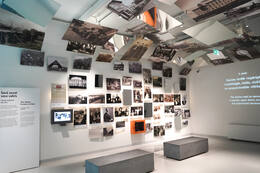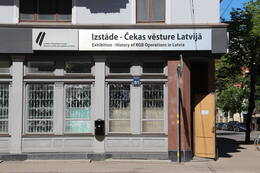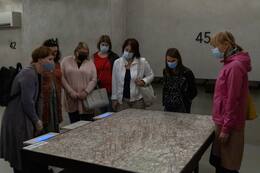Antisowjetische Agitation und Propaganda
IV Sowjetische Okkupation
„Antisowjetische Agitation und Propaganda“ – ein stark ideologischer Begriff, der seit den 1920er Jahren in das Strafrecht der UdSSR eingeführt wurde und einer der am häufigsten verwendeten Gesetzesartikel in politischen Streitigkeiten war. Im Strafgesetzbuch der UdSSR von 1926 wurde die Verantwortlichkeit für Ö antisowjetische Agitation und Propaganda Õ in Artikel 58 festgelegt.
Nach der Besetzung Lettlands im November 1940 wurde dieses Strafgesetzbuch rückwirkend auch in Lettland eingeführt. 1961 wurde das Strafgesetzbuch der Lettischen SSR verabschiedet und in Kraft gesetzt, in dem in Artikel 65 die Verantwortlichkeit für „antisowjetische Agitation und Propaganda“ geregelt wurde. Die in diesem Artikel vorgesehene Strafe sah Ö eine Freiheitsstrafe zwischen sechs Monaten und sieben Jahren Õ und eine Freiheitsstrafe zwischen zwei und fünf Jahren vor. Andererseits sah Artikel 65 Absatz 2 vor, dass Personen, die bereits wegen besonders schwerer öffentlicher Straftaten verurteilt worden waren, mit Freiheitsstrafen von bis zu drei bis zehn Jahren und mit Freiheitsstrafen von zwei bis fünf Jahren zu verurteilen waren.
Im lettischen Staatsarchiv stammen die letzten vom KGB untersuchten politischen Kriminalfälle im Fund of Criminal Cases aus dem Jahr 1986. Viele Dokumente 1980-1990. Um die Wende des 19. Jahrhunderts gelang es dem KGB, nach Russland zu exportieren oder zu vernichten.
Weitere Informationsquellen
Politische Prozesse im besetzten Lettland 1983. Virtuelle Ausstellung. National Archives of Latvia, 2013. http://www.archiv.org.lv/1983/index.php?id=303
Gints Zelmenis, Bruno Javoišs, Ivo Grundulis. Nationale Widerstandsbewegung in Lettland von 1959 bis 1986. Riga, 2019.
Jānis Ķeruss: Widerstand der Tschechischen Republik gegen antisowjetische Propaganda und Agitation. Analyse von 1957. https://www.lu.lv/vdkkomisija/zinas/t/23701/
Mara Miķelsone. Historiker Zelmenis: Das totalitäre Regime war sogar für symbolische Handlungen empfindlich. Ir., 16. September 2019. https://ir.lv/2019/09/16/vesturnieks-zelmenis-totalitarais-rezims-bija-jutigs-pret-simboliskam-akcijam/
Zugehörige Objekte
Lettisches Okkupationsmuseum
Die Museumsausstellung beleuchtet die Geschichte Lettlands von 1940 bis 1991, also die nationalsozialistische und die sowjetische Besatzungszeit.
Das „Haus der Zukunft“ ist ein Projekt des renommierten lettisch-amerikanischen Architekten Gunārs Birkerts zur Renovierung und Erweiterung des lettischen Okkupationsmuseums sowie zur Schaffung einer neuen Ausstellung. Die Ausstellung „Die Geschichte des KGB in Lettland“ befindet sich im sog. Eckhaus, dem ehemaligen Gebäude des Staatssicherheitskomitees der UdSSR (KGB). Das Lettische Okkupationsmuseum wurde 1993 gegründet.
Es erinnert an die lange verdrängte Geschichte Lettlands: den Staat, sein Volk und das Land unter zwei totalitären Mächten von 1940 bis 1991.
2020 umfasste der Museumsfundus mehr als 70000 Objekte (Dokumente, Fotos, schriftliche, mündliche und materielle Zeitzeugnisse, Gegenstände und Erinnerungsstücke). Museumsmitarbeiter haben mehr als 2400 Videozeugnisse aufgezeichnet – eine der größten Sammlungen zum Phänomen Besatzung in Europa. Die Ereignisse, die über die Menschen in Lettland, Litauen und Estland hereinbrachen, sind ein lebendiges Zeugnis für die Erfahrungen der Völker zwischen zwei totalitären Regimen.
Ausstellung zur Geschichte des KGB in Lettland im sog, “Eckhaus”
Das Gebäude der ehemaligen „Tscheka“ – des Staatssicherheitskomitees der UdSSR (später KGB) – in Riga ist heute öffentlich zugänglich. Hier wurden lettische Bürger von im Volksmund so genannten Tschekisten festgehalten, verhört und umgebracht, weil sie das Besatzungsregime als Gegner betrachtete. In dem Gebäude ist heute eine Ausstellung des Lettischen Okkupationsmuseums über die Aktivitäten des KGB in Lettland untergebracht. Es werden Führungen durch Zellen, Gänge, Keller und den Innenhof angeboten. Das Haus wurde 1911 erbaut und zählt zu den schönsten Bauten in Riga. Im Volksmund als „Eckhaus“ bekannt, wurde es zum schrecklichen Symbol des sowjetischen Besatzungsregimes in Lettland - eine der Stützen der Sowjetmacht. Die Tscheka nutzte das „Eckhaus“ während der sowjetischen Besatzung 1940/41 und dann erneut von 1945 bis 1991. Zehntausende Einwohner Lettlands waren von politischer Verfolgung direkt betroffen. Das harte Vorgehen gegen Gegner der sowjetischen Herrschaft wurde auch nach dem Zweiten Weltkrieg fortgesetzt. Nach Stalins Tod änderten sich die Methoden des KGB unwesentlich. An die Stelle von physischer Folter trat nun Psychoterror. Die Mehrheit der Tscheka-Agenten bestand aus ethnischen Letten (52 %). Russen bildeten mit 23,7 % die zweitgrößte Gruppe. 60,3 % der Mitarbeiter gehörten nicht der Kommunistischen Partei an, 26,9 % verfügten über einen Hochschulabschluss. Das System war darauf ausgerichtet, die lokale Bevölkerung einzubinden und so die Kontrolle über die Gesellschaft zu erlangen. Die Korrespondenz und die Akten der KGB-Mitarbeiter befinden sich heute in Russland. Sie sind für lettische Behörden und Historikern nicht zugänglich.
Historische Ausstellung „Das Feuer des Gewissens“
Die historische Ausstellung „Das Feuer des Gewissens“ befindet in der Nähe des Schlossplatzes von Cēsis. Sie wurde in den Arrestzellen für Untersuchungshäftlinge aus der Sowjetzeit eingerichtet und informiert über die Okkupation Lettlands und über erstaunliche und mutige Beispiele des individuellen Widerstandes. Im Hof trägt eine Mauer des Gedenkens die Namen von 643 Einwohnern des ehemaligen Kreises Cēsis, die der sowjetischen Verfolgung zum Opfer fielen: Menschen, die 1941 oder 1949 deportiert wurden sowie erschossene oder zum Tode verurteilte nationale Partisanen. Eine Zeittafel veranschaulicht die Abfolge der Ereignisse in den Besatzungsjahren von 1939 bis 1957. Thematisch geordnete Ausschnitte aus Lokalzeitungen stellen die politische Propaganda beider Besatzungsregime gegenüber. Die sechs Arrestzellen für Untersuchungshäftlinge sind etwa in dem Zustand von 1940/41 und – wie in den Nachkriegsjahren üblich – erhalten. Hier waren Einwohner des Kreises Cēsis wegen verschiedener antisowjetischer Aktivitäten für einige Tage inhaftiert, deren Voruntersuchungen und Verhöre hier stattfanden, bevor sie in die Tscheka (KGB)-Zentrale nach Riga überstellt wurden, darunter nationale Partisanen, Partisanenunterstützer, Jugendliche, die „antisowjetische“ Flugblätter verteilt hatten und andere sog. „Vaterlandsverräter“. Hier ist alles original erhalten - die Arrestzellen nebst den mit Essens-Durchreichen ausgestatteten Eisentüren, Holzpritschen, ein Häftlingsklo, eine kleiner Küchenraum mit Herd und die typischen ölgestrichenen Wände der Sowjetzeit.
2019 gewann die Ausstellung den dritten Platz im alljährlichen nationalen Designwettbewerb Lettlands.
Zugehörige Geschichten
Liepāja - an der Kreuzung verschiedener historischer Ereignisse
Die Einwohner von Liepāja gehörten zu den ersten in Lettland, die den Ausbruch des Zweiten Weltkriegs erlebten, und zu den letzten, für die der Krieg sowohl buchstäblich als auch symbolisch endete. Der Zweite Weltkrieg und die sowjetische Besatzung von Liepāja endeten erst 1994, als die letzten Truppen des Erben der UdSSR, Russland, die Stadt verließen.







